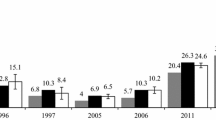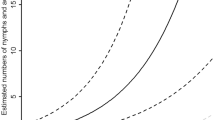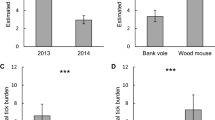Abstract
Despite the presence of Borrelia burgdorferi s.l.-infected Ixodes ricinus ticks in a west of Ireland location, very few small rodents from the same habitats were infected. Most of the infected ticks contained B. garinii or B. valaisiana, which implicates birds as the important reservoir hosts in this location.
Similar content being viewed by others
References
de Boer R, Hovius KE, Nohlmans MK, Gray JS. The woodmouse (Apodemus sylvaticus) as a reservoir of tick-transmitted spirochaetes (Borrelia burgdorferi) in the Netherlands. Zent bl Bakteriol 1993; 279: 404–416.
Gern L, Siegenthaler M, Hu CM, et al. Borrelia burgdorferi in rodents (Apodemus flavicollis and A. sylvaticus): duration and enhancement of infectivity for Ixodes ricinus ticks. Eur J Epidemiol 1994; 10: 75–80.
Tälleklint L, Jaenson TGT. Transmission of Borrelia burgdorferi s.l. from mammal reservoirs to the primary vector of Lyme borreliosis, Ixodes ricinus (Acari: Ixodidae), in Sweden. J Med Entomol 1994; 31: 880–886.
Gray JS, Kahl O, Janetzki C, et al. The spatial distribution of Borrelia burgdorferi-infected Ixodes ricinus in the Connemara region of Co. Galway, Ireland. Exp Appl Acarol 1995; 19: 163–172.
Gray JS, Kirstein F, Robertson JN, et al. Borrelia burgdorferi sensu lato in Ixodes ricinus ticks and rodents in a recreational park in south-western Ireland. Exp Appl Acarol 1999; 23: 1–13.
Gray JS. The development and seasonal activity of the tick, Ixodes ricinus: a vector of Lyme borreliosis. Rev Med Entomol 1991; 79: 323–333.
Rijpkema S, Molkenboer M, Schouls L, et al. Simultaneous detection and genotyping of three genomic groups of Borrelia burgdorferi sensu lato in Dutch Ixodes ricinus ticks by characterization of the amplified intergenic spacer region between 5S and 23S rRNA genes. J Clin Microbiol 1995; 33: 3091–3095.
Robertson J, Murdoch S, Foster L, et al. Isolation and species typing of Lyme borreliosis spirochaetes from UK patients with erythema migrans. Eur J Epidemiol 1999; 15: 499–500.
Estrada-Pena A, Daniel M, Frandsen F, et al. Ixodes ricinus strains in Europe. Zent bl Bakteriol 1998; 287: 185–189.
Kurtenbach K, Kampen H, Dizij A, et al. Infestation of rodents with larval Ixodes ricinus (Acari: Ixodidae) is an important factor in the transmission cycle of Borrelia burgdorferi s.l. in German woodlands. J Med Entomol 1995; 32: 807–817.
Humair PF, Rais O, Gern L. Transmission of Borrelia afzelii from Apodemus mice and Clethrionomys voles to Ixodes ricinus ticks: differential transmission pattern and overwintering maintenance. Parasitology 1999; 118: 33–42.
Gray JS, Kahl O, Janetzki C, Stein J. Studies on the ecology of Lyme disease in a deer forest in County Galway, Ireland. J Med Entomol 1992; 29: 915–920.
Randolph SE, Craine NG. General framework for comparative quantitative studies on transmission of tick-borne diseases using Lyme borreliosis in Europe as an example. J Med Entomol 1995; 32: 765–777.
Matuschka FR, Schinkel TW, Klug B, et al. Failure of Ixodes ticks to inherit Borrelia afzelii infection. Appl Environ Microbiol 1998; 64: 3089–3091.
Gern L, Humair PF. Natural history of Borrelia burgdorferi sensu lato. Wien Klin Wochenschr 1998; 110: 856–858.
Gray JS, Schönberg A, Postic D, et al. First isolation and characterisation of Borrelia garinii, agent of Lyme borreliosis, from Irish ticks. Ir J Med Sci 1996; 165: 24–26.
Richter D, Endepols S, Ohlenbusch A, et al. Geno-species diversity of Lyme disease spirochaetes in rodent reservoirs. Em Inf Dis 1999; 5: 291–296.
Kirstein F, Rijpkema S, Molkenboer M, Gray JS. The distribution and prevalence of B. burgdorferi genomo-species in Ixodes ricinus ticks in Ireland. Eur J Epidemiol 1997; 13: 67–72.
Kirstein F, Gray JS. A molecular marker for the identification of the zoonotic reservoirs of Lyme borreliosis by analysis of the blood meal its European vector, Ixodes ricinus. Appl Environ Microbiol 1996; 62: 4060–4065.
Author information
Authors and Affiliations
Rights and permissions
About this article
Cite this article
Gray, J., Robertson, J. & Key, S. Limited role of rodents as reservoirs of Borrelia burgdorferi sensu lato in Ireland. Eur J Epidemiol 16, 101–103 (2000). https://doi.org/10.1023/A:1007642908546
Issue Date:
DOI: https://doi.org/10.1023/A:1007642908546




